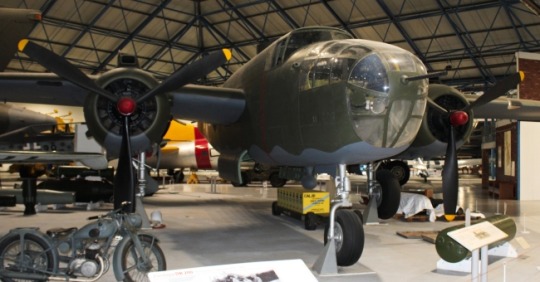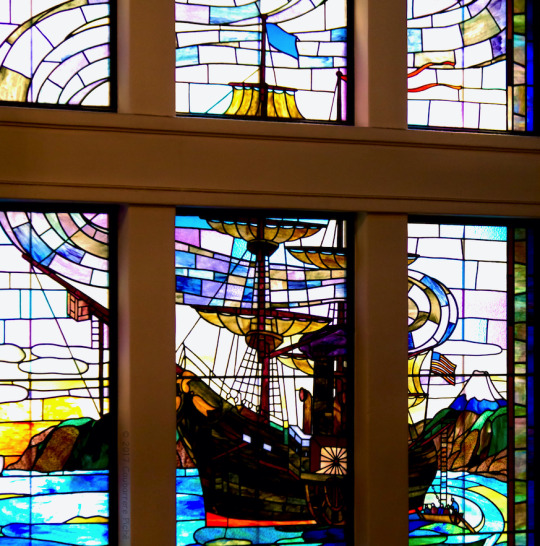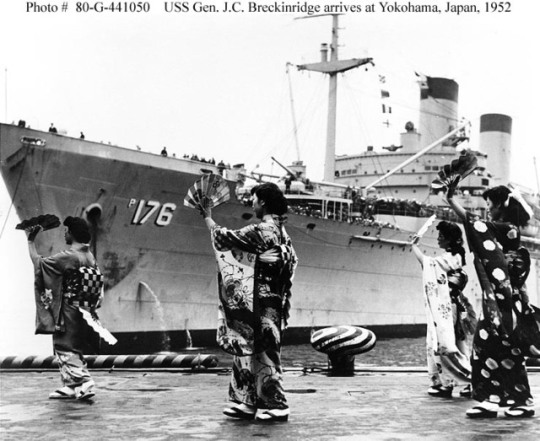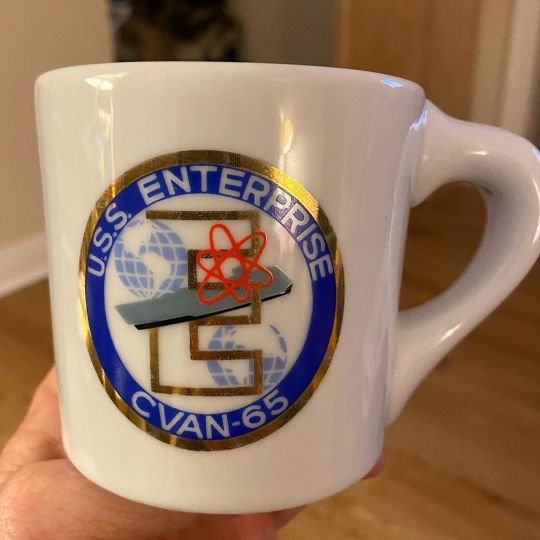#USS Yokohama
Text

Officers of the Imperial Japanese Navy cruiser Nisshin pose on the quarterdeck of USS Missouri (BB-11) with their American counterparts. The visit occurred during Missouri's visit to Yokohama during the voyage of the Great White Fleet.
28 notes
·
View notes
Text

USS Houston (CA-30) in Yokohama harbor on June 22, 1932.
Dennis M. Ogawa Nippu Jiji Photograph Collection
Densho Digital Respository: ddr-njpa-13-64
#USS Houston (CA-30)#USS Houston#Northampton Class#Cruiser#warship#ship#June#1932#interwar period#united states navy#us navy#navy#usn#u.s. navy#my post
15 notes
·
View notes
Text

North American B-25 Mitchell | Classic Warbirds
The roots of the B-25 can be traced back to North American's NA-40 aircraft. This had been undergoing flight tests with the United States Army Air Corps when the aircraft crashed on the 11th April 1939, with all crew members escaping. However, the design showed potential. With the release of the United States Army Air Corps Proposal No 39-640 on the 11th March 1939, which called for a medium bomber capable of a top speed of at least 300 mph, with a range of 2,000 miles with a bomb load of 3,000lb, North American submitted their design, based on the NA-40, the NA-62, with 184 aircraft ordered on the 10th August 1939.

Now known as the B-25, the 19th August 1940 would see the first production example fly. The aircraft would normally have a crew of five, comprising, pilot, co-pilot, bombardier, wireless operator and gunner. Powered by a pair of 1,700-hp Wright R-2600-9 Double Cyclone engines, the B-25 had a top speed of 322 mph, range of 2,000 miles with a service ceiling of 30,000 ft. Armament was one 0.50-in machine-gun and three 0.30-in machine-guns, bomb load was 3,600lb. The B-25 entered service when the 17th Bombardment Group based at McChord Field took delivery of the first example in February 1941.
The B-25A was next and featured armour plating for the crew and self-sealing fuel tanks, with the first example flying on the 24th February 1941. Powered by the same 1,700-hp Wright R-2600-9 Double Cyclone engines as its predecessor, the B-25A had a top speed of 315 mph, range of 1,350 miles and a service ceiling of 27,000 ft. Armament consisted of one 0.50-in machine-gun and three 0.30-in machine-guns, with a bomb load of 3,600lb. The B-25A would enter service as part of the 17th Bombardment Group based at McChord Field, who would also achieve the aircraft's first operational success, when a B-25, flown by Second Lieutenant Everett W. Holstrom, attacked and sunk a Japanese submarine off the West Coast of the United States on the 24th December 1941.

The B-25B, also known as the Mitchell Mk I, followed, and like the two variants before it, was powered by the 1,700-hp Wright R-2600-9 Double Cyclone engine. This had a top speed of 300 mph, range of 1,300 miles with a service ceiling of 25,000 ft. Armament was four 0.50-in machine-guns and one 0.30-in machine-gun. Bomb load was 5,000lb. It was the B-25B that was chosen to take part in an attack on mainland Japan on the 18th April 1942. Sixteen aircraft, led by Lieutenant Colonel James Doolittle, featuring modifications such as autopilot and a 60% increase in fuel capacity, would take-off from the carrier USS Hornet (CV-8) to attack various targets in Japan, including Tokyo and Yokohama. This would become known as the 'Doolittle Raid'.
The 1,700-hp Wright R-2600-13 Double Cyclone powered B-25C, also called the Mitchell Mk II, was the next variant. Its top speed was 284 mph, range 1,500 miles and a service ceiling of 24,000 ft. Armament was six 0.50-in machine-guns, with a bomb load of 5,200lb. This was followed by the B-25D which had the same top speed, range, service ceiling and armament of its predecessor, but was powered by the 2,000-hp Pratt & Whitney R-2800-27 engine. With the first B-25D, with Paul Balfour at the controls, making its maiden flight on the 3rd January 1942.
A pair of B-25Cs would be used to test de-icers. One would become the XB-25E, with the other known as the XB-25F-A.
Entering service in July 1943 the B-25G was designed to attack shipping and was fitted with a 75mm cannon in the nose. Powered by the 1,700-hp Wright R-2600-13 Double Cyclone engine, it had a top speed of 284 mph, range of 1,560 miles and a service ceiling of 24,300 ft. As well as the 75mm cannon the B-25G had armament of five 0.50-in machine-guns and had a bomb load of 3,000lb.
The next variant was the B-25H, which was powered by the 1,700-hp Wright R-2600-13 Double Cyclone engine. This gave the aircraft a top speed of 280 mph, range of 1,350 miles with a service ceiling of 24,300 ft. Armament was one 75mm cannon and twelve 0.50-in machine-guns, bomb load was 3,000lb.

The last production version was the B-25J, also known as the Mitchell Mk III. The 1,700-hp Wright R-2600-13 Double Cyclone engine powered the aircraft giving it a top speed of 272 mph, range of 1,250 miles whilst its service ceiling was 29,000 ft. Armament consisted of twelve 0.50-in machine-guns and its bomb load was 3,000lb.
As well as serving with the United States, the Royal Air Force would also use the B-25 Mitchell, and the type entered operational service with the RAF on the 22nd January 1943, when six aircraft from No. 180 Squadron attacked the oil installations at Ghent, Belgium, three would fail to return. B-25s would serve with various air forces around the world, including Canada, Netherlands and China.
By the time production had finished 9,884 B-25s had been built and served in various roles including reconnaissance and wing de-icing experiments and continued in service outside of the US until 1960.
Technical Details
Click on the aircraft image to view a larger version.
Top Speed Range Service Ceiling Armament
B-25 322 mph 2,000 miles 30,000 ft one 0.50-in machine-gun
three 0.30-in machine-guns
3,600lb bombs
B-25A 315 mph 1,350 miles 27,000 ft one 0.50-in machine-gun
three 0.30-in machine-guns
3,600lb bombs
B-25B 300 mph 1,300 miles 25,000 ft four 0.50-in machine-guns
one 0.30-in machine-gun
5,000lb bombs
B-25B side profile image
B-25C 284 mph 1,500 miles 24,000 ft six 0.50-in machine-guns
5,200lb bombs
B-25D 284 mph 1,500 miles 24,000 ft six 0.50-in machine-guns
5,200lb bombs
XB-25E B-25C modified to test de-icers, one built
XB-25F-A B-25C modified to test de-icers, one built
B-25G 284 mph 1,560 miles 24,300 ft one 75mm cannon
six 0.50-in machine-guns
3,000lb bombs
B-25H 280 mph 1,350 miles 24,300 ft one 75mm cannon
twelve 0.50-in machine-guns
3,000lb bombs
B-25J 272 mph 1,350 miles 29,000 ft twelve 0.50-in machine-guns
3,000lb bombs
6 notes
·
View notes
Photo

Dinner and ping pong 🏓 with Pastor Mike and Julie. We first met them over the summer at a Korean war veteran commemoration aboard the USS Missouri. We later discovered that we have many mutual friends who are pastors from our church in Japan, Every Nation Church Yokosuka and Yokohama. Now Mike is one of the pastors of our church, Harbor Church West Oahu, since his previous church and ours merged. https://www.instagram.com/p/CklyOIYB-G4/?igshid=NGJjMDIxMWI=
0 notes
Video
211121-N-SS370-1010 by U.S. Pacific Fleet
Via Flickr:
TOKYO BAY (Nov. 21, 2021) Quartermaster Seaman Luvima Andrade lowers signal flags as Emory S. Land-class submarine tender USS Frank Cable (AS 40) departs Yokohama, Japan. Frank Cable is on patrol conducting expeditionary maintenance and logistics in support of national security in U.S. 7th Fleet. (U.S. Navy photo by Mass Communication Specialist 2nd Class Chase Stephens)
0 notes
Photo

Stained glass image depicting the sidewheel-steam frigate, USS Powhatan, under the command of Commodore M. C. Perry on his mission to deliver a letter from President Fillmore forcefully demanding that the Japanese Emperor open ports of trade with American ships. The eventual Treaty of Kanagawa was signed on March 5, 1854 in the tiny fishing village of Yokohama. Yokohama Port quickly expanded trade with the U.S., France, the U.K., and Russia transforming the village of Yokohama into a vibrant metropolitan port city welcoming cultures, technology, art, and ideas for political reform from around the world into Japan. ISO 1600 at ƒ/5 for 1/80 sec. #stainedglass #antiquewindow #neorenaissance #YokohamaPortOpeningMemorialHall #Japan #ポーハタン号 #黒船来��� #ペリー提督 #横浜市開港記念会館 #PentaxKS2
#stained glass#antique window#Neo-renaissance#Yokohama Port Opening Memorial Hall#Japan#ポーハタン号#黒船来航#ペリー提督#横浜市開港記念会館#Pentax K-S2
10 notes
·
View notes
Photo

USS General J. C. Breckinridge is greeted by Japanese Geisha as she arrives at Yokohama Army Port with Servicemen's dependents on board, 1952.
26 notes
·
View notes
Photo

皆さま毎度こんばんは。 今夜は店主の気まぐれで入荷する、アメリカからの買い付けアイテムa.k.a飛び道具、デッドストックのミリタリーCAPをご紹介させていただきます。 アメリカ海軍の戦艦"USS Iowa, BB-61"のワッペンがついたデッドストックのSHIP CAP。 デザイン、色合い、プライスもGOOD。3600円也。 ぶっ飛びそうな予感がします。お早めにどうぞ。 詳しくは画像リンク先のウェブストアもしくはわたくしのプロフィールリンク先のブログにてご確認下さいませ。 #mensfashion #mensclothing #classical #classicstyle #americantraditional #vintagestyle #メンズファッション #newoldstock #militarycap #ussiowa #ussiowabattleship (Rhythm Yokohama) https://www.instagram.com/p/B8inPa5pHbQ/?igshid=1k59dj1d9d1p2
#mensfashion#mensclothing#classical#classicstyle#americantraditional#vintagestyle#メンズファッション#newoldstock#militarycap#ussiowa#ussiowabattleship
1 note
·
View note
Text
Events 4.18
796 – King Æthelred I of Northumbria is murdered in Corbridge by a group led by his ealdormen, Ealdred and Wada. The patrician Osbald is crowned, but abdicates within 27 days.
1428 – Peace of Ferrara between Republic of Venice, Duchy of Milan, Republic of Florence and House of Gonzaga: ending of the second campaign of the Wars in Lombardy fought until the Treaty of Lodi in 1454, which will then guarantee the conditions for the development of the Italian Renaissance.
1506 – The cornerstone of the current St. Peter's Basilica is laid.
1518 – Bona Sforza is crowned as queen consort of Poland.
1521 – Trial of Martin Luther begins its second day during the assembly of the Diet of Worms. He refuses to recant his teachings despite the risk of excommunication.
1689 – Bostonians rise up in rebellion against Sir Edmund Andros.
1738 – Real Academia de la Historia ("Royal Academy of History") is founded in Madrid.
1775 – American Revolution: The British advancement by sea begins; Paul Revere and other riders warn the countryside of the troop movements.
1783 – Three-Fifths Compromise: the first instance of black slaves in the United States of America being counted as three fifths of persons (for the purpose of taxation), in a resolution of the Congress of the Confederation. This was later adopted in the 1787 Constitution.
1831 – The University of Alabama is founded in Tuscaloosa, Alabama.
1847 – American victory at the battle of Cerro Gordo opens the way for invasion of Mexico.
1857 – "The Spirits Book" by Allan Kardec is published, marking the birth of Spiritualism in France.
1864 – Battle of Dybbøl: A Prussian-Austrian army defeats Denmark and gains control of Schleswig. Denmark surrenders the province in the following peace settlement.
1897 – The Greco-Turkish War is declared between Greece and the Ottoman Empire.
1899 – The St. Andrew's Ambulance Association is granted a royal charter by Queen Victoria.
1902 – The 7.5 Mw Guatemala earthquake shakes Guatemala with a maximum Mercalli intensity of VIII (Severe), killing between 800 and 2,000.
1906 – An earthquake and fire destroy much of San Francisco, California.
1909 – Joan of Arc is beatified in Rome.
1912 – The Cunard liner RMS Carpathia brings 705 survivors from the RMS Titanic to New York City.
1915 – French pilot Roland Garros is shot down and glides to a landing on the German side of the lines during World War I.
1916 – White war on the Italian front (World War I): during a mine warfare in high altitude on the Dolomites, the Italian troops conquer the Col di Lana held by the Austrian army.
1917 – The II Italian Corps in France leaves from Italy for the western front: it will distinguish itself during the Third Battle of the Aisne and the Second Battle of the Marne, in Bligny and on the sector Courmas - Bois du Petit Champ, where it will considerably contribute to stop the German offensive on Eparnay, aimed to outflank Reims.
1923 – Yankee Stadium: "The House that Ruth Built" opens.
1925 – The International Amateur Radio Union is formed in Paris.
1930 – The British Broadcasting Corporation announced that "there is no news" in their evening report.
1939 – Robert Menzies, who became Australia's longest-serving prime minister, is elected as leader of the United Australia Party after the death of Prime Minister Joseph Lyons.
1942 – World War II: The Doolittle Raid on Japan: Tokyo, Yokohama, Kobe and Nagoya are bombed.
1942 – Pierre Laval becomes Prime Minister of Vichy France.
1943 – World War II: Operation Vengeance, Admiral Isoroku Yamamoto is killed when his aircraft is shot down by U.S. fighters over Bougainville Island.
1945 – Over 1,000 bombers attack the small island of Heligoland, Germany.
1946 – The International Court of Justice holds its inaugural meeting in The Hague, Netherlands.
1949 – The Republic of Ireland Act comes into effect.
1949 – The keel for the aircraft carrier USS United States is laid down at Newport News Drydock and Shipbuilding. However, construction is canceled five days later, resulting in the Revolt of the Admirals.
1954 – Gamal Abdel Nasser seizes power in Egypt.
1955 – Twenty-nine nations meet at Bandung, Indonesia, for the first Asian-African Conference.
1980 – The Republic of Zimbabwe (formerly Rhodesia) comes into being, with Canaan Banana as the country's first President. The Zimbabwean dollar replaces the Rhodesian dollar as the official currency.
1983 – A suicide bomber in Lebanon destroys the United States embassy in Beirut, killing 63 people.
1987 – The New York Islanders defeat the Washington Capitals 3–2 in Game 7 of their Patrick Division Semifinal series.
1988 – The United States launches Operation Praying Mantis against Iranian naval forces in the largest naval battle since World War II.
1996 – In Lebanon, at least 106 civilians are killed when the Israel Defense Forces shell the United Nations compound at Qana where more than 800 civilians had taken refuge.
1997 – The Red River flood begins and soon overwhelms the city of Grand Forks, North Dakota. Fire breaks out and spreads in downtown Grand Forks, but high water levels hamper efforts to reach the fire, leading to the destruction of 11 buildings.
1999 – Wayne Gretzky, the National Hockey League's all-time points scorer, plays his final game at Madison Square Garden as a teammate of the New York Rangers in a 2–1 overtime loss to the Pittsburgh Penguins. Gretzky recorded his final career point, an assist, bringing his career point total to 2,857.
2007 – A series of bombings, two of them being suicides, occur in Baghdad, killing 198 and injuring 251.
2008 – The inaugural season of the Indian Premier League kicks off with a match between Kolkata Knight Riders and Royal Challengers Bangalore. During this match, KKR's opener Brendon McCullum "clobbered"[10] 158 not out off 73 balls, the highest score in Twenty20 history at the time.
2013 – A suicide bombing in a Baghdad cafe kills 27 people and injures another 65.
2018 – King Mswati III of Swaziland announces that his country's name will change to Eswatini.
2019 - A redacted version of the Mueller Report is released to the United States Congress and the public.
0 notes
Text

North American B-25 Mitchell | Classic Warbirds
The roots of the B-25 can be traced back to North American's NA-40 aircraft. This had been undergoing flight tests with the United States Army Air Corps when the aircraft crashed on the 11th April 1939, with all crew members escaping. However, the design showed potential. With the release of the United States Army Air Corps Proposal No 39-640 on the 11th March 1939, which called for a medium bomber capable of a top speed of at least 300 mph, with a range of 2,000 miles with a bomb load of 3,000lb, North American submitted their design, based on the NA-40, the NA-62, with 184 aircraft ordered on the 10th August 1939.
Now known as the B-25, the 19th August 1940 would see the first production example fly. The aircraft would normally have a crew of five, comprising, pilot, co-pilot, bombardier, wireless operator and gunner. Powered by a pair of 1,700-hp Wright R-2600-9 Double Cyclone engines, the B-25 had a top speed of 322 mph, range of 2,000 miles with a service ceiling of 30,000 ft. Armament was one 0.50-in machine-gun and three 0.30-in machine-guns, bomb load was 3,600lb. The B-25 entered service when the 17th Bombardment Group based at McChord Field took delivery of the first example in February 1941.
The B-25A was next and featured armour plating for the crew and self-sealing fuel tanks, with the first example flying on the 24th February 1941. Powered by the same 1,700-hp Wright R-2600-9 Double Cyclone engines as its predecessor, the B-25A had a top speed of 315 mph, range of 1,350 miles and a service ceiling of 27,000 ft. Armament consisted of one 0.50-in machine-gun and three 0.30-in machine-guns, with a bomb load of 3,600lb. The B-25A would enter service as part of the 17th Bombardment Group based at McChord Field, who would also achieve the aircraft's first operational success, when a B-25, flown by Second Lieutenant Everett W. Holstrom, attacked and sunk a Japanese submarine off the West Coast of the United States on the 24th December 1941.
The B-25B, also known as the Mitchell Mk I, followed, and like the two variants before it, was powered by the 1,700-hp Wright R-2600-9 Double Cyclone engine. This had a top speed of 300 mph, range of 1,300 miles with a service ceiling of 25,000 ft. Armament was four 0.50-in machine-guns and one 0.30-in machine-gun. Bomb load was 5,000lb. It was the B-25B that was chosen to take part in an attack on mainland Japan on the 18th April 1942. Sixteen aircraft, led by Lieutenant Colonel James Doolittle, featuring modifications such as autopilot and a 60% increase in fuel capacity, would take-off from the carrier USS Hornet (CV-8) to attack various targets in Japan, including Tokyo and Yokohama. This would become known as the 'Doolittle Raid'.
The 1,700-hp Wright R-2600-13 Double Cyclone powered B-25C, also called the Mitchell Mk II, was the next variant. Its top speed was 284 mph, range 1,500 miles and a service ceiling of 24,000 ft. Armament was six 0.50-in machine-guns, with a bomb load of 5,200lb. This was followed by the B-25D which had the same top speed, range, service ceiling and armament of its predecessor, but was powered by the 2,000-hp Pratt & Whitney R-2800-27 engine. With the first B-25D, with Paul Balfour at the controls, making its maiden flight on the 3rd January 1942.
A pair of B-25Cs would be used to test de-icers. One would become the XB-25E, with the other known as the XB-25F-A.
Entering service in July 1943 the B-25G was designed to attack shipping and was fitted with a 75mm cannon in the nose. Powered by the 1,700-hp Wright R-2600-13 Double Cyclone engine, it had a top speed of 284 mph, range of 1,560 miles and a service ceiling of 24,300 ft. As well as the 75mm cannon the B-25G had armament of five 0.50-in machine-guns and had a bomb load of 3,000lb.
The next variant was the B-25H, which was powered by the 1,700-hp Wright R-2600-13 Double Cyclone engine. This gave the aircraft a top speed of 280 mph, range of 1,350 miles with a service ceiling of 24,300 ft. Armament was one 75mm cannon and twelve 0.50-in machine-guns, bomb load was 3,000lb.
The last production version was the B-25J, also known as the Mitchell Mk III. The 1,700-hp Wright R-2600-13 Double Cyclone engine powered the aircraft giving it a top speed of 272 mph, range of 1,250 miles whilst its service ceiling was 29,000 ft. Armament consisted of twelve 0.50-in machine-guns and its bomb load was 3,000lb.
As well as serving with the United States, the Royal Air Force would also use the B-25 Mitchell, and the type entered operational service with the RAF on the 22nd January 1943, when six aircraft from No. 180 Squadron attacked the oil installations at Ghent, Belgium, three would fail to return. B-25s would serve with various air forces around the world, including Canada, Netherlands and China.
By the time production had finished 9,884 B-25s had been built and served in various roles including reconnaissance and wing de-icing experiments and continued in service outside of the US until 1960.
Technical Details
Click on the aircraft image to view a larger version.
Top Speed Range Service Ceiling Armament
B-25 322 mph 2,000 miles 30,000 ft one 0.50-in machine-gun
three 0.30-in machine-guns
3,600lb bombs
B-25A 315 mph 1,350 miles 27,000 ft one 0.50-in machine-gun
three 0.30-in machine-guns
3,600lb bombs
B-25B 300 mph 1,300 miles 25,000 ft four 0.50-in machine-guns
one 0.30-in machine-gun
5,000lb bombs
B-25B side profile image
B-25C 284 mph 1,500 miles 24,000 ft six 0.50-in machine-guns
5,200lb bombs
B-25D 284 mph 1,500 miles 24,000 ft six 0.50-in machine-guns
5,200lb bombs
XB-25E B-25C modified to test de-icers, one built
XB-25F-A B-25C modified to test de-icers, one built
B-25G 284 mph 1,560 miles 24,300 ft one 75mm cannon
six 0.50-in machine-guns
3,000lb bombs
B-25H 280 mph 1,350 miles 24,300 ft one 75mm cannon
twelve 0.50-in machine-guns
3,000lb bombs
B-25J 272 mph 1,350 miles 29,000 ft twelve 0.50-in machine-guns
3,000lb bombs
Back to the top
4 notes
·
View notes
Photo

Doolittle Raid Bombarderos medianos B-25 Mitchell a bordo del portaaviones USS Hornet El 18 de abril de 1942, los aviadores de las Fuerzas Aéreas del Ejército de EE. UU., Dirigidos por el teniente coronel James H. (Jimmy) Doolittle, llevaron la Batalla del Pacífico al corazón del imperio japonés con una incursión sorprendente y audaz contra objetivos militares en Tokio, Yokohama, Yokosuka, Nagoya y Kobe. https://www.instagram.com/p/CBWV2IZgBsS/?igshid=hpokv5rhgno0
0 notes
Video
211121-N-SS370-1001 by U.S. Pacific Fleet
Via Flickr:
TOKYO BAY (Nov. 21, 2021) A Japanese tug pulls alongside Emory S. Land-class submarine tender USS Frank Cable (AS 40) as the ship departs Yokohama, Japan. Frank Cable is on patrol conducting expeditionary maintenance and logistics in support of national security in U.S. 7th Fleet. (U.S. Navy photo by Mass Communication Specialist 2nd Class Chase Stephens)
0 notes
Text
THE EVIDENCE MOUNTS
THE WORLD, accustomed to blaming every illness on a bacterium or virus, has been ignoring the enemy that we have invited in and mistaken for a friend. The evidence is mounting, not only that it is futile to try to hide from a microscopic gene sequence that has already flooded the earth, over which we have no control, but that the illnesses that are being blamed on that virus, and which rightly terrify us, are in part caused by an enemy that we ourselves have created, and that we have refused to recognize as the mortal threat that it is.
It is not a coincidence that Wuhan, China turned on its first 5G communication network just two weeks before the first known person became ill there with a disease that has since shut down the world. It is not a coincidence that the Diamond Princess cruise ship set sail with 5G satellite communication antennas on board, immediately before the same disease sickened hundreds of its passengers. It is not a coincidence that Germany, this spring, brought 4G-LTE technology for the first time to areas near its borders immediately before small birds began dying in large numbers in precisely those areas.
Viruses are constituent elements of life on Earth. Microwave radiation is foreign and lethal to life on Earth. It is time that humanity recognizes these facts.
THE DIAMOND PRINCESS On February 3, 2020, the Diamond Princess cruise ship was quarantined in Yokohama, Japan after a passenger had tested positive for COVID-19. Ultimately, 381 passengers and crew members became sick, and 14 died. It later emerged that COVID-19 had probably spread throughout the ship before the quarantine began. The quarantine -- on the ship as in the rest of society -- was a futile attempt to control the uncontrollable, like plugging up a hole in a dam, or a thousand or a million holes, while most of the water is actually washing over the dam and flooding on top of us.
On February 3, 2020, the same day the Diamond Princess was quarantined, the satellite company SES put out a press release advertising “the best WiFi at sea” and announcing that Princess Cruises would be using a “hybrid medium earth orbit (MEO) and geostationary (GEO) network” to become “the first cruise ships to access SES’s ground-breaking O3b mPOWER satellite-based communications system.”
mPOWER uses beam-forming technology and frequencies from 17 to 30 GHz and SES boasts that its satellite system is part of the global 5G network. “We offer the fastest wifi on the high seas making it easier for you to stream movies, stay connected on social media and even text with friends and family on board with you!” advertises Princess Cruises. Each Princess ship has 7,000 sensors, 650 wall-mounted touchscreen devices, 1,780 WiFi access points, 4,030 digital displays in private rooms, and 75 miles of cable. The antennas on the ships that communicate with the satellites are huge globes that look like this:
mPower was operating on the Diamond Princess at the time of the coronavirus outbreak. A photograph of the Diamond Princess on February 5, 2020 while it was quarantined in Yokohama shows the five antenna globes that it had on board:
SOCIAL DISTANCING FOR BIRDS?
“A previously unidentifed disease is currently threatening blue tits, great tits and other small songbirds across Germany,” reported the German conservation organization NABU. The first cases were reported on March 11, 2020, and by April 21 the number of reported sick and dead birds was around 26,000. Although this disease is being blamed on a bacterium, its resemblance to COVID-19 cannot be avoided. The birds are being described as “apathetic birds with breathing problems.” They cannot eat, appear to be “unquenchably thirsty,” and then die. Extreme thirst is a widely-reported effect of microwave radiation. It is also commonly reported in cases of COVID-19.
Absurdly, NABU is telling people to stop providing feeding stations and water sources in order to enforce “social distancing” for birds. NABU has published a map of German regions showing the number of reported tit deaths per 100,000 inhabitants:
The highest number of bird deaths is occurring along the Mosel River and in the region around Oldenburg in Lower Saxony. These are areas where Vodafone announced in a press release on April 10, 2020 that it had just expanded its 4G-LTE cell tower network. Vodafone said it had closed "one of the nastiest radio holes" in Lower Saxony, and there had previously only been 2G service along the Mosel River. “The company has implemented more than 1,000 LTE projects in the past few months," said Vodafone, and is increasing the power of 500 existing LTE stations and upgrading 260 more stations to 4G-LTE.
MYSTERY DISEASE IN YOUNG CHILDREN
We have been told that COVID-19 is a serious disease mainly in the elderly, and that it does not affect young children. Now, however, an unknown disease is being described in children in the United Kingdom, Spain, Italy and the United States and since many of them are testing positive for COVID-19, it is being blamed on that virus -- despite the fact that other children with the new disease have tested negative for the virus.
Children are appearing with “multi-system inflammation with flu-like symptoms,” and “with blood parameters consistent with severe COVID-19.” The children may be agitated, confused, have severe difficulty breathing, have seizures, low blood pressure, inflammation of the heart, abdominal pain, skin rash and, especially in teenage boys, testicular pain. The disease is being called a variant of either toxic shock syndrome or Kawasaki disease. But the symptoms are all classic effects of radio wave sickness.
AN OCEAN OF VIRUSES
The idea that we can keep from sharing viruses by wearing masks and staying a few feet away from each other is about as realistic as putting a mask on a fish and pretending it is going to protect it from getting wet. Viruses are nothing but pieces of genetic material that constitute the basis of life itself. It is coming to be understood that there is an ocean of bacteria and viruses that circulate in the atmosphere and travel on high-altitude winds around the world and between continents. And that the viruses far outnumber the bacteria.
It has long been a mystery how, from one season to the next, an old strain of the influenza virus can be replaced by a new strain, at the same time all over the world. This is now being explained. A team of Canadian scientists, in a paper about influenza, observed that viral particles may be transported hundreds or thousands of kilometers before returning to the ground and that “the Far East may be a source of wintertime influenza viral aerosols that reach North America a week or two after they are emitted into the atmosphere... Thus, the entire population of the world may become exposed to airborne influenza virus. This may help to explain the ubiquity and persistence of this disease.”
This could also explain how sailors on the Navy ship, USS Kidd, could have contracted the coronavirus after more than a month at sea without any contact with land. The ship left Pearl Harbor on March 20, 2020, and the first sailor started showing symptoms of the disease on April 22. Subsequently the ship was quarantined in San Diego, where 64 sailors tested positive for COVID-19.
But viruses are much more than vectors of disease.
Viruses, wrote an international team of scientists in a paper published in 2018, “encompass much of the biological diversity on the planet.” There are an estimated 1,000,000,000,000,000,000,000,000,000,000 virus particles in the oceans alone. To determine the number of viruses circulating high in the atmosphere, these authors established two collection stations in the Sierra Nevada Mountains of Spain, and counted viruses. They found, at those locations, that between 0.3 billion and 7 billion virus particles per day were falling out of the air onto every square meter of land, originating from both land and ocean sources far away.
“The daily deposition rates of viruses associated with aerosols <0.7 µm in size explains observations that identical viral sequences occur at geographically distant locations and in very different environments,” wrote these authors. They also found evidence that “bacteria and viruses can remain viable after atmospheric transport... Rather than being a negative consequence, this deposition provides a seed bank that should allow ecosystems to rapidly adapt to environmental changes.”
“Viruses,” wrote a pair of scientists from San Diego State University ("Here a virus, there a virus, everywhere the same virus?"), “are ubiquitous, abundant and ecologically important in the environment.”
Those who are telling us to stay home, wear masks and practice social distancing have a myopic, extremely limited, and wrong understanding of viruses, their function in the world, and how they circulate. The COVID-19 virus is already circulating on the wind, everywhere in the world. Masks, disinfectants, social distancing, and staying home accomplish nothing. As more than one doctor has observed, it is rational to quarantine the sick, but irrational to quarantine the healthy.
Arthur Firstenberg
P.O. Box 6216
Santa Fe, NM 87502
USA
phone: +1 505-471-0129
https://www.5gSpaceAppeal.org
April 5, 2020
A pdf version of this newsletter is available here:
https://www.cellphonetaskforce.org/wp-content/uploads/2020/05/The-Evidence-Mounts.pdf




0 notes
Photo

I need another coffee mug like I need another hole in the head, but I couldn’t pass this one up. Pre-1975 USS Enterprise (CVAN-65) mug, made in Yokohama. #usn #usnavy #navyism #USSEnterprise #CVAN65 #CV65 #TheBigE #FlyNavy https://www.instagram.com/p/B7aERWKgrDy/?igshid=1lma514256lw5
0 notes
Photo

こんにちは。 昨日に続きBUZZ RICKSON’Sの新作、アメリカ製のプリントTシャツをご紹介させていただきます。 今回はブラックをコーディネート。 ヴィンテージのミリタリーを復刻するバズリクソンだけにプリントモチーフはU.S. NAVY。 ボディーは脇に繋ぎ目の無い丸胴、首回りは伸びにくいバインダーネック。 プリントは染み込みプリントを採用。 プリントデザインからから推測するに、ベトナム戦争時でも70年代頃、U.S. NAVYの航空母艦USS Coral Sea(コーラル・シー)の船員達によるトンキン湾(TONKIN GULF)でのヨットクラブのグラフィックだと思います。 軍モノでありマリンな感じのアイテムです。 #mensfashion #mensclothing #outfit #ootd #menscoordinate #americancasual #classical #classicstyle #americantraditional #vintagestyle #buzzrickson #buzzricksons #militarytshirt #militarystyle #workstyle #usnavy #marinestyle #madeinusa #madeintheusa #メンズファッション #メンズコーディネート #メンズコーデ #バズリクソンズ #バズリクソン #ミリタリーtシャツ #アメリカ製 (Rhythm Yokohama)
#militarystyle#ootd#バズリクソン#buzzrickson#mensclothing#menscoordinate#classical#アメリカ製#americancasual#ミリタリーtシャツ#marinestyle#メンズコーデ#vintagestyle#メンズファッション#workstyle#classicstyle#americantraditional#バズリクソンズ#madeinusa#madeintheusa#mensfashion#メンズコーディネート#usnavy#buzzricksons#militarytshirt#outfit
1 note
·
View note

